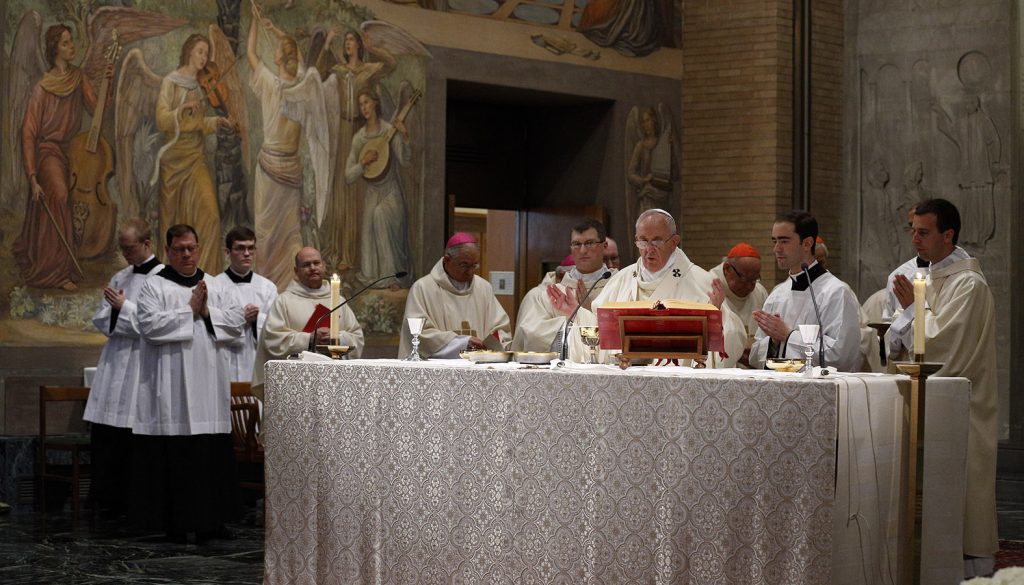ROME — Memos posted on bulletin boards from seminary rectors rarely make news anywhere outside the campus, but one put up Aug. 31 from Father Peter Harman to the community at Rome’s Pontifical North American College (NAC) was an exception to the rule. In short, its message was: no more pre-Vatican II Mass here.
The note explains that when Pope Benedict XVI liberalized permission for celebration of the older Mass in 2008, the NAC began offering training for celebrating the so-called Tridentine-rite Mass and slotted in a weekly older Mass on Saturdays. Now that Pope Francis has retracted that permission, however, the NAC will no longer offer the training and the Saturday Mass will be replaced with the new version of the Mass celebrated in Latin.
It’s a small reminder that, against all odds, Pope Francis, after 8 1/2 years on the job, seems destined to leave behind a considerable liturgical legacy.
It’s not what people expected in April 2013, when a Jesuit pope was elected. By reputation, Jesuits are fairly indifferent to the liturgy. As the old joke goes, a Jesuit liturgy is like an airplane landing. No matter how bumpy it may have been, as long as you can walk away safely, it was a success.
Naturally, that’s unfair to all those Jesuits who take worship seriously, not to mention a number of great Jesuit liturgists. Until his death in 2018, for example, American Jesuit Father Robert Taft was probably the English-speaking world’s greatest authority on the liturgies of Eastern Catholicism from his perch at Rome’s Pontifical Oriental Institute.
Still, it’s true that the Jesuits have never prioritized liturgy in the way other orders do. Ignatius never established a tradition of common prayer, wanting Jesuits to be free to pursue the Church’s pastoral needs.
Thus when a Jesuit pope was elected in 2013, most devotees of matters liturgical had low expectations.
Yet Pope Francis is also keenly politically astute, so he’s well aware of the old adage “lex orandi, lex credendi” (“the law of worship is the law of faith”). As a result, and against the script, he’s steadily gone about trying to reshape the way Catholics pray and worship.
In general, Pope Francis’ top liturgical priority appears to be to recapture and consolidate the vision expressed in the progressive liturgical movement that led up to the Second Vatican Council (1962-65), and which was codified in the original reforms issued after the council under St. Pope Paul VI.
Pope Francis’ signature move in that regard, clearly, is “Traditionis Custodes” (“Guardians of the Tradition”), the July 16 “motu proprio” (“on one’s own initiative”) with which the pontiff withdrew the permissions for celebrating the older Mass granted by his predecessor. In so doing, Pope Francis argued that while Pope Benedict hoped his concessions would foster greater unity in the Church, experience has shown the results to be greater division instead.
“To doubt [Vatican II] is to doubt the intentions of those very fathers who exercised their collegial power in a solemn manner “cum Petro et sub Petro” (“with Peter and under Peter”) in an ecumenical council, and, in the final analysis, to doubt the Holy Spirit itself who guides the Church,” the pope insisted.
The clear aim of “Traditionis Custodes” is to ensure that all Catholics eventually celebrate only the reformed liturgy that followed Vatican II.
In keeping the management adage that personnel is policy, Pope Francis has backed up his commitment to the Vatican II agenda by ensuring that figures who share his vision are now in charge of liturgical policy.
After years of tolerating the more tradition-minded Cardinal Robert Sarah of Guinea as his prefect of the Congregation for Divine Worship and the Discipline of the Sacraments, Pope Francis in May appointed English Archbishop Arthur Roche to that post, someone more in keeping with the pope’s own preferences.
Just days ago, Pope Francis also named Msgr. Guido Marini, who had been in charge of the pope’s own liturgical celebrations under both Pope Benedict and Pope Francis, as the new bishop of Tortona in the northern Italian region of Piedmont. The transfer means the pope now will be able to appoint a new master of liturgical ceremonies, presumably someone also in sync with what the pontiff wants.
Another key decision came in September 2017, with another “motu proprio” titled “Magnum Principium” (“The Great Principle”), the gist of which was to shift most authority for translation of liturgical texts into the vernacular languages away from Rome and to local bishops’ conferences.
The question of who’s in charge of translation had been a bone of contention for much of the post-Vatican II period, and the drift under Pope John Paul II and Pope Benedict had been for the Vatican to assert steadily greater control. In general, that was a prescription for more traditional language, notably in the most recent English translation of the texts for Mass.
Pope Francis turned that tendency on its head, saying he is acting to ensure that Vatican II’s call to make the liturgy more understandable to people is “more clearly reaffirmed and put into practice.”
To invoke the classic double negative of Vatican-speak, Pope Francis’ effort to reshape the liturgy is not uncontroversial. In the wake of the NAC announcement, for example, one pro-Latin Mass website declared that the pontiff is waging “systemic cultural genocide” on traditionalist Catholics. Time will tell whether his changes stick, or whether some future pope decides to reopen some doors he’s tried to slam shut.
Whatever the case, it seems safe to say that, once again, Pope Francis has defied expectations. A papacy expected to be fairly somnambulant with regard to the liturgy has turned out to be anything but.

